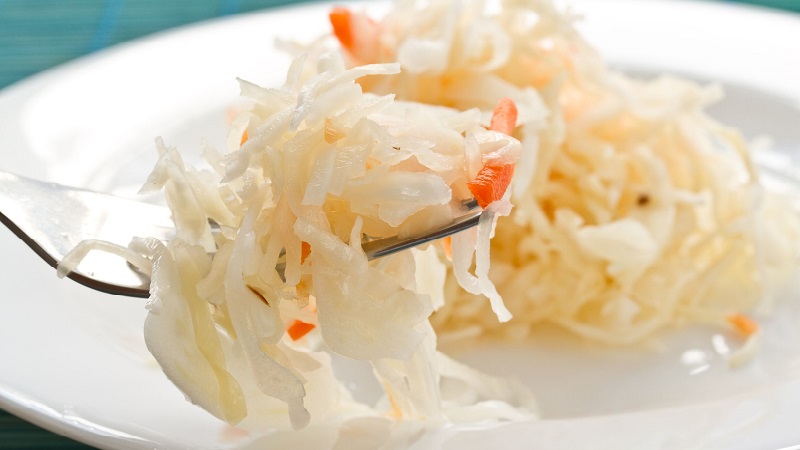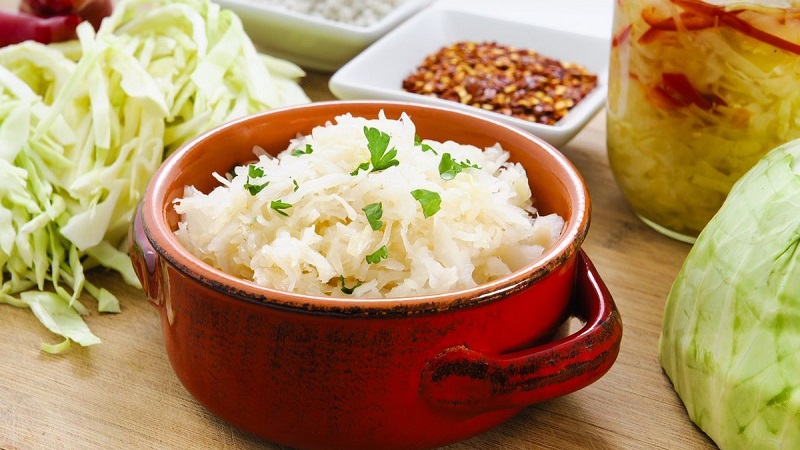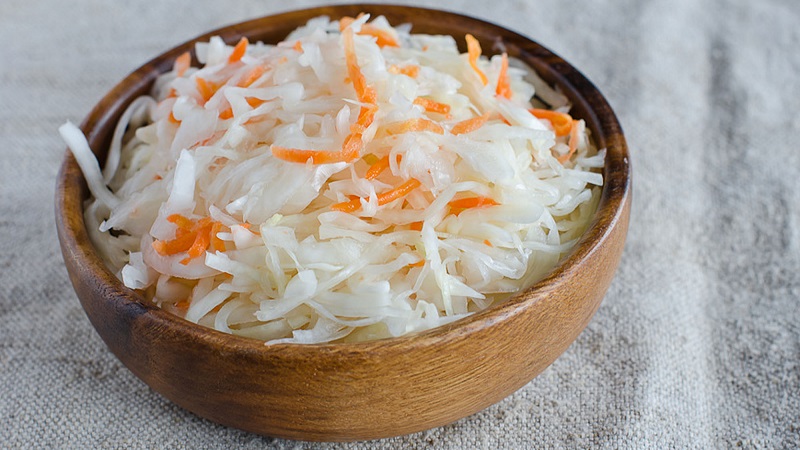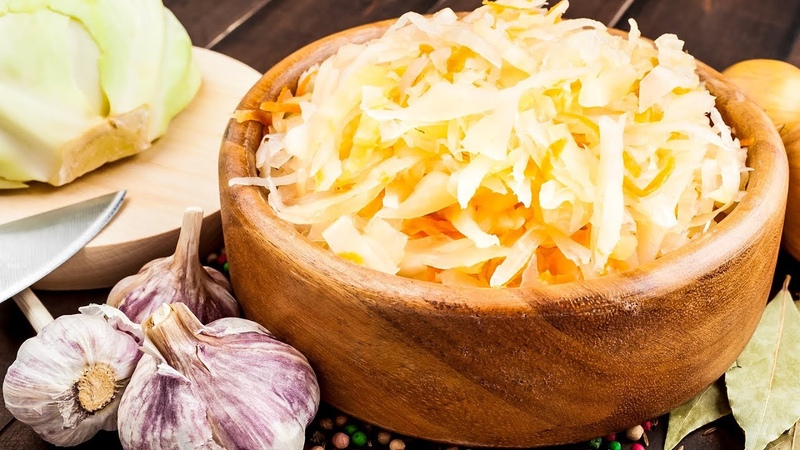What is fermented cabbage, why is it good and how is it prepared
The human body assimilates the required amount of nutrients only if there is a healthy microflora in the intestines. Fermented products are actively involved in its creation, that is, those that have been cold preserved in liquid. Fermented cabbage is much easier to digest in the digestive tract thanks to the living, beneficial bacteria. In addition, the vegetable in this form becomes much healthier and tastier.
The content of the article
What is Fermented Cabbage
Everyone is familiar with the fermentation process - it takes place with the participation of lactic acid bacteria when pickling vegetables, fruits or any other products. Hence, fermented cabbage is sauerkraut... Vegetables prepared in this way are considered one of the most valuable and healthy foods.

How fermentation takes place
Fermentation is a vacuum fermentation process in which organic matter is broken down into simpler forms. At the same time, microorganisms are formed - bacteria, yeast and fungi, which multiplying, begin to process the sugar and starch contained in the product, and in return form lactic acid, releasing vitamins and other useful substances.
Lactic acid protects the vegetable from spoilage and has a beneficial effect on digestion. As a result of lactic acid fermentation, a fermented product is obtained, which is much more nutritious and healthier than the original one. It is enriched with vitamins B, K, C, omega-3 fatty acids and various types of probiotics.
Reference. Sauerkraut contains 20 times more easily digestible vitamin C than fresh cabbage.
What does cabbage taste like?
Fermented cabbage is good because the taste of a fresh vegetable is almost completely preserved with this method of canning. In addition, a live product is obtained, because all the beneficial bacteria contained in it do not die, as during salting and pickling. Vegetables are not exposed to either high or low temperatures.
When using ingredients such as onion, garlic, ginger in recipes, the main thing is not to overdo it with the amount, since fermentation enhances the aromas several times. Fermentation results in a spicy, crunchy and tasty dish.
The benefits and harms of the product

Research proves that a perfect balance of bacteria in your gut is essential for physical, mental and emotional health. And to stabilize it, there is the most affordable and simple way - the use of fermented cabbage, as well as other similarly cooked vegetables.
What are their benefits:
- The content of beneficial bacteria contributes to the processing of food into easily digestible molecules.
- Fermented cabbage is absorbed faster, as it has already been partially digested under the influence of beneficial microflora.
- Mineral compounds become more bioavailable for the body. They are absorbed faster and better into the bloodstream when compared to fresh cabbage.
- The body's defenses are strengthened.
- The microflora of the stomach and intestines is restored, especially after taking antibiotics, when beneficial microorganisms die.
- Fermented food helps rid the body of toxins and free radicals.
Scientific research has proven that good microflora living in a healthy gut environment reduces the risk of almost any form of acute or chronic illness.
In addition to the listed benefits, fermented cabbage has other beneficial effects:
- sleep improves;
- the level of energy, vigor increases;
- the risk of developing inflammatory processes decreases;
- heartburn goes away;
- the motor function of the stomach is improving;
- regular use of the product helps not only maintain adequate body weight, but also lose weight through many mechanisms.
The microflora and other microorganisms that live inside the intestines are essential for the health of the brain, heart, lungs, liver and digestive system.
Despite many health benefits, sauerkraut can also cause harm:
- If salt was used during fermentation, the product will provoke fluid retention in the body, which will lead to an increase in blood pressure.
- A vegetable prepared in this way removes iodine from the body, which is vital for the functioning of the thyroid gland.
- The acetic acid contained in sauerkraut has an adverse effect on gastrointestinal diseases.
Which cabbage is right

It is undesirable to use early vegetable varieties, since they have a loose tissue and an insufficient sugar content for fermentation - the product will be of poor quality. For this purpose, medium and late varieties.
It is recommended to use:
- mid-season - Belarusian, Mozharskaya, Slava Gribovskaya;
- late maturing - Amager, Moscow late, Slavyanka.
Selection of vegetables
The heads of cabbage should be dense, with strong leaves, but without coarse venation, white color, without purple pigment. Sluggish and affected upper leaves are not used for fermentation.
The degree of maturity of a vegetable is determined by the density of the formed head of cabbage, which must weigh at least 0.7 kg. It is desirable to process large forks. The larger they are, the less waste during processing.
Training
To make the process of making fermented cabbage fast and efficient, the following steps are taken:
- Prepare a workplace that will occupy almost the entire table.
- The top polluted, green and defective leaves are removed from the head of cabbage, the stump is cut off. The peeled vegetable is processed on the same day.
- Rinse thoroughly under running water.
- Cut into two halves.
- Thoroughly wash the containers for sauerkraut and disinfect with vinegar.
If the fermentation recipe calls for carrots, apples, beets or bell peppers, they are also peeled and washed well.
How to ferment cabbage

The process of preparing the product is simple, does not require a lot of effort and time. The result is a wonderful dish with many virtues.
What is necessary
For fermentation, a temperature of about + 21 ° C is preferred. It takes about five weeks to complete the process. It is important to isolate oxygen, as it stimulates the growth of fungal microorganisms, the presence of which in the workpiece is undesirable.
Important. One of the main mistakes made during fermentation is that cabbage is transferred to the refrigerator too early, not keeping it warm for a sufficient time. For maximum therapeutic effect, cabbage needs to go through all three stages of fermentation.
Fermentation instructions
This process takes into account two important points:
- The vegetable is fermented without salt. Salt, acting as a preservative, inhibits the development of "good" bacteria, most of which die.
- Cabbage is fermented without air access under a hermetically sealed lid. This is due to the fact that lactobacilli reproduce much more actively in such an environment. During fermentation without air access, the “good” bacteria remain alive for many days and months, even when the product is stored in the refrigerator.
Perhaps not everyone will like unleavened cabbage without salt, but before serving it can be supplemented with spices, olive oil, herbs, onions, cranberries, etc.
Fermentation method without salt

Having prepared all the necessary ingredients, dishes, cutting tools, proceed directly to the execution of the process:
- Prepared cabbage is chopped or chopped, getting shavings as in ordinary pickling or larger, as recommended. This saves the maximum amount of nutrients.
- Placed in a jar and tamped tightly so that there are no air formations between the layers.
- The jar is filled only up to the "shoulders", since the contents will increase in volume during fermentation. The free space will be occupied by water, which is added to the container.
- The vegetable mixture is poured with filtered water and tightly closed with a lid.
In this state, they are left for 2-3 days at room temperature. - If the cabbage is fermented in a large vessel (ceramic pot), cover the vegetable mixture with a piece of cotton cloth, then apply a wooden undercutting circle and put the oppression itself so that a layer of liquid of 3-5 cm forms over the circle.
To improve the taste of a vegetable dish, carrots cut into circles or strips are added, sometimes apples, berries - lingonberries or cranberries. Spices are also used - cumin or bay leaf.
How to check readiness
When the water in the jar becomes cloudy, it means that the fermentation process has started. From this moment, they taste the juice, cabbage and determine: whether they like the taste, whether it is sour enough, continue fermentation in a warm place or remove it for storage in the refrigerator. In this case, focus on your own taste preferences and find suitable options.
Storing fermented cabbage
The jar with the contents is moved to a cooler place - the basement or refrigerator... Under such conditions, the fermentation process slows down and the dish can be stored for up to several months.
Take out the cabbage from the container for consumption with only a clean spoon.
How and with what to serve
Fermented cabbage is eaten both as an independent dish and as an ingredient in many recipes: salads, vinaigrette, pies, dumplings, borscht, soups, cabbage rolls.
The product goes well with meat or potatoes... It is better to boil or bake the meat. The same is recommended for potatoes.
If you season the cabbage with unrefined oil and onions sweet varieties, you get a wonderful salad that can be eaten with any other products or just with bread.
Contraindications to use
Fermented cabbage is contraindicated for people who have:
- Peptic ulcer of the stomach and intestines.
- Acute and chronic catarrhal gastritis.
- Any kidney disease, accompanied by a decrease in their functional ability. Large amounts of organic acids in cabbage increase symptoms.
- Allergy to a fermented product.
Conclusion
Fermented cabbage is rich in vitamins and minerals, without which the full activity of the human body is impossible. However, it is required to fulfill the condition for successful fermentation - to create a vacuum in the container. This method has many advantages, but do not forget about possible contraindications.